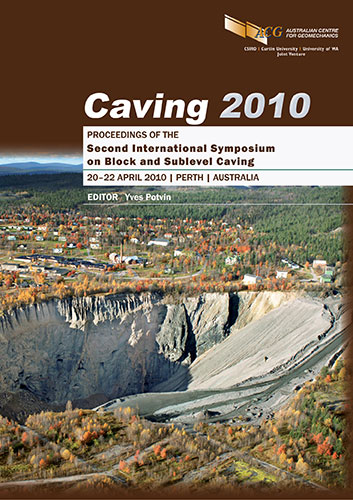Simulation of the rock caving process using a mesh-free method

|
Authors: Karekal, S; Das, R; Mosse, L; Cleary, PW |
DOI https://doi.org/10.36487/ACG_rep/1002_35_Karekal
Cite As:
Karekal, S, Das, R, Mosse, L & Cleary, PW 2010, 'Simulation of the rock caving process using a mesh-free method', in Y Potvin (ed.), Caving 2010: Proceedings of the Second International Symposium on Block and Sublevel Caving, Australian Centre for Geomechanics, Perth, pp. 509-521, https://doi.org/10.36487/ACG_rep/1002_35_Karekal
Abstract:
Understanding the caving process and material flow is fundamental to block and sublevel cave mining, and also longwall mining in sedimentary deposits. However, due to complexity of the structure of the rock mass and its behaviour, the caving process is rarely understood and cannot be described by simple mathematical models. Numerical methods that solve the governing partial differential equations with appropriate boundary conditions have been employed in modelling geomechanics problems. Notably, mesh-based finite element, boundary element and finite difference methods or combinations of these methods have been employed effectively for stress analysis for simulating rock excavations. However, when modelling caving processes, such as block caving, sublevel caving and longwall caving, the traditional mesh-based continuum approaches may fail to simulate such a process due to large material movement, fracture and fragmentation. This is mainly due to inaccuracies arising from mesh distortions resulting in spurious and ill conditioned models, and their deficiency to capture large material flows and fragmentations. In this paper, an application of a mesh-free method, called smoothed particle hydrodynamics (SPH), is demonstrated for simulating rock caving in a stratified deposit. The advantages for simulating caving processes using a mesh free numerical framework are highlighted. Two different examples are chosen, one with elastic-brittle material behaviour with a large yield strength (failure by brittle fracture) and the other with elasto-plastic material behaviour with a relatively lower yield strength to allow ductile deformation of the rock mass. The modelling results capture the mechanistic aspects observed in caving processes. It is shown that the large-scale deformation and the associated fracture processes in caving can be effectively simulated using SPH. In the authors’ knowledge, this work is the first attempt in demonstrating the application of a mesh-free method for simulating caving processes.
References:
ADDIN EN.REFLIST Aliabadi, M.H. and Rooke, D.P. (1991) Numerical Fracture Mechanics, Computational Mechanics Publications and Kluwer Academic Publishers.
Bailey, J. (2003) Findings and recommendations: Inquest into the deaths of R. Bodkin; M. House; S. Osman and
C. Lloyd-Jones on the 24th November, 1999 at the E26 Lift 1 Mine, Northparkes Mines, Parkes, New South Wales, NSW Coroners Court.
Barker, D.B., Fourney, W.L. and Dally, J.W. (1978) The influence of stress waves on explosive induced fragmentation-borehole crack network, 19th US Symposium on Rock Mechanics, Lake Tahoe.
Belytschko, T. and Black, T. (1999) Elastic crack growth in finite elements with minimal remeshing, International Journal for Numerical Methods in Engineering, Vol. 45, pp. 601–620.
Belytschko, T., Moes, N., Usui, S. and Parimi, C. (2001) Arbitrary discontinuities in finite elements, International Journal for Numerical Methods in Engineering, Vol. 50, pp. 993–1013.
Brown, E.T. and Bray, J. (1987) Analytical and Computational Methods in Engineering Rock Mechanics, Allen & Unwin.
Cleary, P., Ha, J., Alguine, V. and Nguyen, T. (2002) Flow modelling in casting processes, Applied Mathematical Modelling, Vol. 26, pp. 171–190.
Cleary, P.W., Prakash, M. and Ha, J. (2006) Novel applications of smoothed particle hydrodynamics (SPH) in metal forming, Journal of Materials Processing Technology, Vol. 177, pp. 41–48.
Cleary, P.W., Prakash, M., Ha, J., Stokes, N. and Scott, C. (2007) Smooth particle hydrodynamics: status and future potential, Progress in Computational Fluid Dynamics, Vol. 7, pp. 70–90.
Gingold, R.A. and Monaghan, J.J. (1977) Smoothed particle hydrodynamics - Theory and application to non-spherical stars, MNRAS, Vol. 181, pp. 375–389.
Grady, D.E. and Kipp, M.E. (1980) Continuum modelling of explosive fracture in oil shale, International Journal of Rock Mechanics and Mining Sciences and Geomechanics Abstracts, Vol. 17, pp. 147–157.
Gray, J.P. and Monaghan, J.J. (2004) Numerical modelling of stress fields and fracture around magma chambers, Journal of Volcanology and Geothermal Research, Vol. 135, pp. 259–283.
Gray, J.P., Monaghan, J.J. and Swift, R.P. (2001) SPH elastic dynamics. Computer Methods in Applied Mechanics and Engineering, Vol. 190, pp. 6641–6662.
Imaeda, Y. and Inutsuka, S-I. (2002) Shear Flows in Smoothed Particle Hydrodynamics, The Astrophysical Journal, Vol. 569, pp. 501–518.
Libersky, L.D. and Petschek, A.G. (1990) Smooth particle hydrodynamics with strength of materials, In Advances in the Free-Lagrange Method, Trease and Crowley (eds), Berlin: Springer.
Liu, Z.S., Swaddiwudhipong, S. and Koh, C.G. (2004) High velocity impact dynamic response of structures using SPH method, International Journal of Computational Engineering Science, Vol. 5, pp. 315–326.
Lucy, L.B. (1977) A numerical approach to the testing of the fission hypothesis, Astronomical Journal, Vol. 82,
pp. 1013–1024.
Melosh, H.J., Ryan, E.V. and Asphaug, E. (1992) Dynamic fragmentation in impacts: hydrocode simulation of laboratory impacts, Journal of Geophysical Research, Vol. 97, pp. 14735–14759.
Moes, N., Dolbow, J. and Belytschko, T. (1999) A finite element method for crack growth without remeshing, International Journal for Numerical Methods in Engineering, Vol. 46, pp. 131–150.
Monaghan, J.J. (1992) Smoothed particle hydrodynamics, Annual Review of Astronomy and Astrophysics, Vol. 30,
pp. 543–574.
Monaghan, J.J. (2005) Smoothed particle hydrodynamics, Reports on Progress in Physics, Vol. 68, pp. 1703–1759.
Rabczuk, T., Song, J.H. and Belytschko, T. (2009) Simulations of instability in dynamic fracture by the cracking particles method, Engineering Fracture Mechanics, Vol. 76, pp. 730–741.
Thorne, B.J., Hommert, P.J. and Brown, B. (1990) Experimental and computational investigation of the fundamental mechanisms of cratering, 3rd International Symposium on Rock Fragmentation by Blasting, Brisbane, Australia, pp. 117–124.
Wingate, C.A. and Fisher, H.N. (1993) Strength Modeling in SPHC, Los Alamos National Laboratory, Report No. LA-UR-93-3942.
© Copyright 2025, Australian Centre for Geomechanics (ACG), The University of Western Australia. All rights reserved.
View copyright/legal information
Please direct any queries or error reports to repository-acg@uwa.edu.au
View copyright/legal information
Please direct any queries or error reports to repository-acg@uwa.edu.au